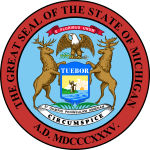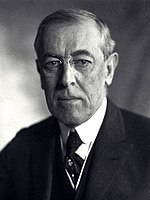| ||||||||||||||||||||||||||
All 15 Michigan votes to the Electoral College | ||||||||||||||||||||||||||
|---|---|---|---|---|---|---|---|---|---|---|---|---|---|---|---|---|---|---|---|---|---|---|---|---|---|---|
| ||||||||||||||||||||||||||
 County Results
| ||||||||||||||||||||||||||
| ||||||||||||||||||||||||||
| Elections in Michigan |
|---|
 |
The 1916 United States presidential election in Michigan took place on November 7, 1916, as part of the 1916 United States presidential election. Voters chose 15[1] representatives, or electors, to the Electoral College, who voted for president and vice president.
Following the Panic of 1893 and the Populist movement, Michigan would turn from a competitive Republican-leaning state into a rigidly one-party polity dominated by the Republican Party.[2] The dominance of the culture of the Lower Peninsula by anti-slavery Yankees[3] would be augmented by the turn of formerly Democratic-leaning German Catholics away from that party as a result of the remodelled party's agrarian and free silver sympathies, which became rigidly opposed by both the upper class and workers who followed them.[4] The state Democratic Party was further crippled via the Populist movement severing its critical financial ties with business and commerce in Michigan as in other Northern states.[5] A brief turn of the strongly evangelical Cabinet Counties toward the Populist movement in the 1896 presidential election would reverse itself following the return to prosperity under President William McKinley, so that these joined in Republican hegemony until the Great Depression.
In the 1894 elections, the Democratic Party lost all but one seat in the Michigan legislature,[6] and over the four ensuing decades the party would never make major gains there.[2] Unlike the other states of the Upper Midwest, the Yankee influence on the culture of the Lower Peninsula was so strong that left-wing third parties did not provide significant opposition to the Republicans, nor was there more than a moderate degree of coordinated factionalism within the hegemonic Michigan Republican Party.[7]
Aided by the support of incumbent Governor Chase Osborn[8] and state party leader Frank Knox,[9] “Bull Moose” nominee Theodore Roosevelt would carry Michigan by a double-digit margin over conservative incumbent Taft in 1912. However, Roosevelt's personal interests took over from developing his party after the election,[10] and after voting on the first ballot for favorite son Henry Ford due to his strong desire to keep America out of World War I,[11] Michigan's Republicans would soon shift their support in the national convention to eventual nominee Charles Evans Hughes.[12]
At the beginning of the campaign, Michigan, where Republicans had regained their customary near-monopoly of House and state legislative seats in 1914, was seen by the Hughes campaign as a safe state.[13] However, early polls, taken only from rural areas of Central Michigan, indicated Wilson was receiving a substantial proportion of the 1912 “Bull Moose” vote.[14] No further polls would be taken in the state, and in the end Hughes won slightly more than 52 percent of the popular vote.[15]
- ^ "1916 Election for the Thirty-Third Term (1917-1921)". Retrieved April 3, 2018.
- ^ a b Burnham, Walter Dean (December 23, 1981). "The System of 1896: An Analysis". The Evolution of American Electoral Systems. Bloomsbury Academic. pp. 178–179. ISBN 0313213798.
- ^ English, Gustavus P.; Proceedings of the Ninth Republican National Convention (1888), p. 234
- ^ Sundquist, James (December 2010). Politics and Policy: The Eisenhower, Kennedy, and Johnson Years. Brookings Institution Press. p. 526. ISBN 978-0815719090.
- ^ Rogowski, Ronald (2020). Commerce and Coalitions: How Trade Affects Domestic Political Alignments. Princeton University Press. ISBN 978-0691219431.
- ^ "Swamped! The Democrats Drowned Out by a Tremendous Republican Tidal Wave". The L'Anse Sentinel. L'Anse. November 10, 1894. p. 1.
- ^ Hansen, John Mark; Shigeo, Hirano; Snyder Jr., James M. (February 27, 2017). "Parties within Parties: Parties, Factions, and Coordinated Politics, 1900-1980". In Gerber, Alan S.; Schickler, Eric (eds.). Governing in a Polarized Age: Elections, Parties, and Political Representation in America. Cambridge University Press. pp. 165–168. ISBN 978-1-107-09509-0.
- ^ Pavord, Andrew C. (Summer 1996). "The Gamble for Power: Theodore Roosevelt's Decision to Run for the Presidency in 1912". Presidential Studies Quarterly. 26 (3): 633–647.
- ^ Mark, Steven Macdonald (1977). An American Interventionist: Frank Knox and United States Foreign Relations (Thesis). pp. 32–55.
- ^ Gould, Lewis L. The First Modern Clash over Federal Power: Wilson versus Hughes in the Presidential Election of 1916. p. 12.
- ^ Lovell, S.D. (1980). The Presidential Election of 1916. Southern Illinois University Press. p. 28. ISBN 0809309653.
- ^ Lovell; The Presidential Election of 1916
- ^ Gould; The First Modern Clash over Federal Power, p. 78
- ^ "Greatest Statesman We Have Ever Had — So Says Luther Burbank, Famous Scientist, of Wilson". Telegraph-Forum+date=September 22, 1916. Bucyrus, Ohio.
- ^ "1916 Presidential General Election Results — Michigan". Retrieved April 3, 2018.


